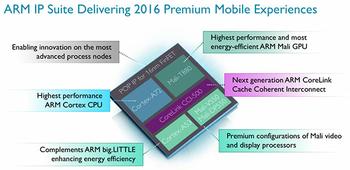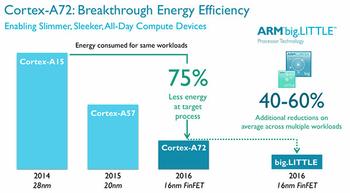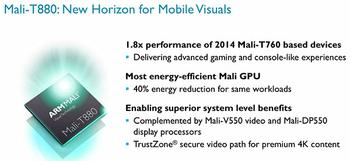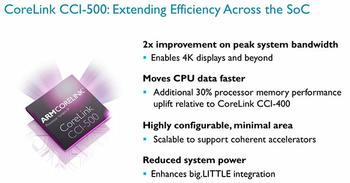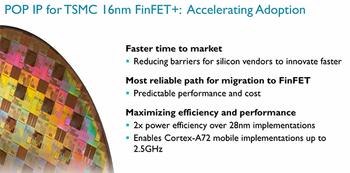This evening ARM has announced a range of new IPs which will provide a "New Standard for the Premium Mobile Experience," from 2016 and beyond. The highlight among the announcements tonight is probably the new ARMv8-A-based ARM Cortex-A72 processor. This CPU offers users a 50X performance hike compared to ARM's leading edge chips from just five years ago, according to the Cambridge, UK-based chip designer. Other key announcements include an updated GPU in the form of the ARM Mali -T880, the ARM CoreLink CCI-500 Cache Coherent Interconnect and the optimisation of the architecture for TSMC's 16nm FinFET+ process.
Of course chip designers like ARM don't boost the performance of processor designs just for benchmark numbers but do so to enable new mobile experiences. ARM says that the new 'Premium Mobile Experience' provided by its new chip designs will bring users the following:
- Console quality gaming
- Multi-casting UHD and 4K video streams
- Local natural language processing
- Redefined levels of content creation – including still image/video capture and processing
- Improved battery life and better thermals thanks to better energy efficiency
- Slimmer form factors
How big a step up from the ARM Cortex-A57 does the new Cortex-A72 processor represent? ARM says that users of current gen ARM-based devices could enjoy a 3.5X increase in performance compared to today's latest and greatest mobile chips within the same power budget. Pete Hutton, executive vice president and president, products groups, signals that ARM is beginning to look beyond mobile devices to larger screened mobile compute devices and "in 2016 the ARM ecosystem will deliver even slimmer, lighter, more immersive mobile devices that serve as your primary and only compute platform".
Cortex-A72 CPU
The ARM Cortex A-72 processor is based upon the ARMv8-A architecture. It is a 64-bit chip that is fully backwards compatible with 32-bit software. The key benefit of the new CPU is that it can provide 3.5X the performance of 2014 devices based on the Cortex-A15 processor. In another other use-case, device makers can produce 2014 performance matching gadgets that deliver a 75 per cent reduction in energy consumption. The ARM Cortex A-72 processor can be used in big.LITTLE processor configurations alongside the Cortex-A53 CPU to provide extended performance and efficiency.
Mali-T880 GPU
A lot of the enhanced capabilities on offer from a mobile experience in 2016 will rely on a powerful but power sipping GPU. ARM's new Mali-T880 is said to offer a "ground-breaking mobile graphics and visual experience". In numerical terms the new GPU "delivers 1.8X the graphics performance of today’s Mali-T760 based devices and a 40 percent reduction in energy consumption across identical workloads," according to ARM's own testing.
Together with the Mali-V550 video processor and Mali-DP550 display processor the new GPU can output to 4K 120fps resolution displays with high fidelity 10-bit YUV support and handle hardware HEVC decoding, rotation, scaling and post processing. Premium 4K content is capable of being enjoyed but secured via ARM TrustZone.
CoreLink CCI-500
In an ARM designed SoC leveraging the new CPU and GPU mentioned above the CoreLink CCI-500 provides the all important interconnects. Again this IP is faster and more energy efficient offering "double the peak memory system bandwidth and a 30 percent increase in processor memory performance compared to the previous generation CoreLink CCI-400". Overall this improves system responsiveness, thanks to its acceleration of memory intensive workloads such as multimedia content creation and consumption.
ARM POP IP for advanced TSMC 16nm FinFET+
ARM's POP IP can simplify vendors' work in migrating from 32/28nm process nodes to the TSMC 16nm FinFET+ process. With TSMC's new process ARM says that Cortex-A72 processors could scale to 2.5GHz in smartphones and higher in larger screened devices with their typically larger power envelopes. The Mali-T880 is also supported by POP IP.
TSMC Senior Director, Design Infrastructure Marketing Division, Suk Lee noted that "TSMC's 16FinFET+ process is already delivering exceptional results with SoCs based on Cortex-A57 thanks to rapid progress in yield and performance". Lee predicts that TSMC customers will bring 16FinFET+ SoCs based on the Cortex-A72 to market early in 2016.
So far ARM has already signed up more than 10 chipmaker licensees including; HiSilicon, MediaTek and Rockchip. ARM says that technical information fleshing out today's announcements will be published later on this year.




